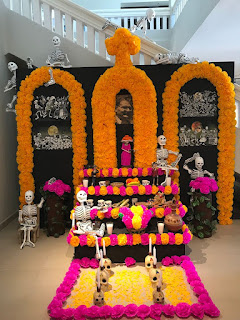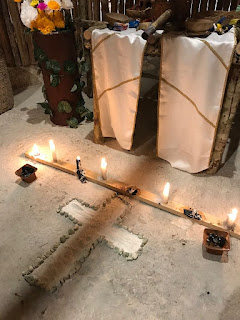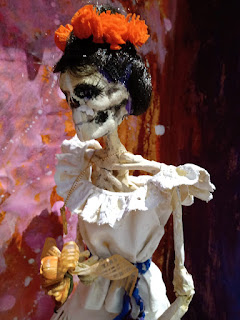La Muerte a través de los ojos de Posada
Exposición Colectiva
Museo de la Isla de Cozumel.
(English version below)
"Para la juventud de ahora lo más fácil es robar, dedicarse a la delincuencia deberían entregarse al arte, es más sano, necesitamos más que nada espacios para el arte para que ellos vayan viendo cual es la intensión de esto, como dicen esto es libre y todos deberíamos ver la función del arte. yo me dedico a trabajar aparte y me costeo todas mis pinturas, todo esto es un esfuerzo desde afuera y cuando estás, vale la pena haber invertido en esos días, vale la pena"
José Esteban Dzul Tec
Colorida y llena de vida para los que ya no la tienen en este mundo, es el arte que se presenta en el lobby del Museo de la Isla de Cozumel. 26 obras creativas están expresadas por Yvonne Angelica Aridjis, Víctor Manuel Chi Lugo, Verónica Ochoa Guarneros, Uriel Cab, Tatiana Biermas Reichgruber, Rocío Albarran Q, Orlando Silvio Silvera Hernández, Myrna Cleghorn, Michelle González Ávila, María del Pilar Orozco, Lupita Peralta Mendoza, Luis Pereza Ojeda, Lhoyo, Lucio Frías Correa, José Esteban Dzul Tec, Greg Dietrich, Gabriela del Socorro Medina Puerto, Erick Giovani Orozco Garza, Daniel Aguilar, Cristina Canto Chulim, Clarissa Marisol Vivas Mena, Arturo Castañeda Gamboa, Ángel Vivas Mena, Rehos, Alfonso Viladiu, Addy Bacelis
"No que no chiquitina"
obra de Rocío Albarran Q
(detalle de obra)
Poniendo atención a las obras.
"Catrina Garbancera" obra de Arturo Castañeda (izquierda)
y "Catrina X" obra de Lucio Frías Correa (derecha)
Al ser entrevistada la licenciada Sako museógrafa del Museo de la Isla de Cozumel sobre esta actividad, comentó que este tipo de exposiciones que organiza la institución cada vez es mejor la aceptación que tiene por parte de los pintores, grabadores, escultores y fotógrafos que habitan la isla de Cozumel
. "Esto significa que este tipo de tradiciones de México inspiran bastante la creatividad, hay mucho interés en trabajar en esto" Finalmente Sako se sintió complacida por la asistencia a la inauguración que poco a poco retorna como lo era antes de la pandemia, "Es muy gratificante sentir la presencia de todos. Visiten el Museo de la Isla hay buena obra expuesta en todo el resinto"

Alfonso Viladiu, María del Pilar Orozco, Gabriela medina,
Rocío Albarran Q, Lupita Peralta Mendoza, Uriel Cab
(de izquierda a derecha)
¡Llevame contigo! obra de Michelle González Ávila,
"Cempasúchil eterno" obra de Yvonne Angelica Aridjis Fuentes
Pintura de José Esteban Dzul Tec y su Familia
Entrevista a José Esteban Dzul Tec
-¿Tu nombre por favor?
- José Esteban Dzul Tec y soy artista de aquí de Cozumel
-¿Cuanto llevas pintando?
-Llevo pintando ya siete años y es la tercera vez que participo aquí en el museo.
-¿De que trata tu pintura?
-La obra trata de la vida a través del infinito, hice un tema elaborado un poco de la película Coco, aunque te vayas al infinito siempre escucharas la música que más te guste y te liberará el alma.
Son tradiciones que debemos seguir, es muy interesante seguir poco a poco la cultura de aquí de Cozumel y de todos los lados de la república Mexicana Pienso que son tradiciones que debemos seguir en el arte y la cultura.
-¿Qué piensas de esta exposición colectiva?
-La verdad a sido muy interesante que nos hayan dado la oportunidad de participar como artista local me siento muy contento de estar aquí. Cada uno tiene un buen talento, cada uno tiene lo suyo, hay nivel de pintura de arte, se muestra lo que le gusta a cada uno sobre todo en la diversidad de colores cada quien tiene lo suyo. veo que son más cuadros que el año pasado. el interés hacia la exposición ha sido incrementada. Fue muy interesante como fueron acomodados los cuadros en el montaje, como le digo la pintura es lo básico de lo que se trata al tema que tenemos involucrado el día de hoy.
-¿Cómo fue tu capacitación?
-En realidad no tuve ninguna, esto lo conocí en la calle , mi otro lado es grafiti y acrílico, así empecé a ver como eran los trabajos, Aquí en el museo curioseando también aprendí. Aquí tuve unos comienzos, soy autodidacta.
-¿Cuál a sido tu inspiración?
-Mi inspiración es mi familia y que ellos vean que es lo que tengo adentro y que la gente también vea algunos de mis trabajos. Para mi Familia siento que el arte es algo muy grande porque en realidad somos pocos que nos dedicamos a esto y le ponemos mucho empeño, amor. Empeño porque es dedicación y tiempo. Las horas que se invierten en el arte estoy con ellos y es productivo porque en el momento que estas pintando o dibujando ellos lo hacen también, esa es la manera que ellos empiezan a conocer poquito más el arte, empiezan a preguntar como se hace esto y esto entonces nosotros aprendemos de los niños y ellos de nosotros siento que es una combinación buena.
-¿Qué sientes que le falta a la isla respecto al arte?
-Siento que muchos deberían involucrase, para la juventud de ahora lo más fácil es robar, dedicarse a la delincuencia deberían entregarse al arte, es más sano, necesitamos más que nada espacios para el arte para que ellos vayan viendo cual es la intensión de esto, como dicen esto es libre y todos deberíamos ver la función del arte. Yo me dedico a trabajar aparte y me costeo todas mis pinturas, todo esto es un esfuerzo desde afuera y cuando estás, vale la pena invertir esos días, vale la pena.
-¿Entonces vale la pena?
-Vale la pena.
-¿Algo más que quieras decir?
-Muchas gracias por el apoyo porque estoy aquí en el museo, gracias a usted que tengo la oportunidad que me este entrevistando, es la primera vez que tengo la experiencia que me entrevisten.
"Brindemos por papá"
obra de Orlando Silvio Silvera Hernández
(a su izquierda su esposa)
"El Chaleco"
obra de Ángel Vivas Mena
Admirando las obras en la parte alta del museo
"Sonriele a la muerte" (detalles)
de la obra de Gabriela del Socorro Medina Puerto
"En tu recuerdo"
de Erick Giovani Orozco
"El tiempo" Obra de Verónica Ochoa (izquierda)
"#noal4toMuelle"Obra de Tatiana Biermas Reichgruber (derecha)
Obra de Rehos
Obra de Lhoyo
Asistente admirando
"Una noche con posada"
obra de Greg Dietrich
Infantes gozando la exposición
Altares



Exponentes y directora y museógrafa
del Museo de la isla de Cozumel.
LUPITO
Cuentan por ahí que José Guadalupe Posada, tenía el hábito
de salir por las calles en las noches para serenar su mente después de un arduo
trabajo en su taller de grabado, cuando sentía que ya estaba tranquilo revisaba
sus bolsillos para encontrar algunas monedas para dirigirse después a su
cantina favorita "EL OSO", le
gustaba ese lugar porque siempre había gente del pueblo que le comentaba sus
anécdotas, las inconformidades con el gobierno y observaba sus desfiguros,
también veía uno que otro grupo de catrines haciéndolos aún más, todos saboreaban esos santísimos pulques que ahí
preparaban.
En El OSO Lupito como le conocían a Posada ahí
bebía de manera excesiva, tanto así que en su delirio etílico juraba ver bailar
a las meseras con osos. Sentía que todo era un bizarro mundo de endemoniados
osos, que en ocasiones según el estado de ánimo de ellos se comían a los
clientes hasta dejarlos en purititos huesos, pero que después de la media noche
volvían a cobrar vida y continuaban bebiendo y bailando. Lupito reía a
carcajadas, pues eran de sus escenas favoritas le inspiraban a seguir
produciendo esas imágenes de grabado de esqueletos humanos viviendo su
cotidianidad mexicana.
Lupito en sus últimos
instantes de vida murió reflejando en sus pupilas las imágenes de aquellos osos
infernales bailadores, Cuentan también que algún amigo teporocho que en sus
mejores días de trasnochadas en el Oso visito a la fosa común dónde fue
enterrado y le arrojó una botella de mezcal para que tuviera un buen viaje.
Bueno, eso es lo que cuentan las malas lenguas de los
encatrinados porfiristas que vivían enfurecidos por sus mensajes visuales de
Lupito hacia ellos.

Death through Posada's eyes
Group Exhibition
Cozumel Island Museum.
"For the youth of today the easiest thing is to steal, to dedicate themselves to crime, they should devote themselves to art, it is healthier, we need more than anything spaces for art so that they can see what the intention of this is, as they say this is free and we should all see the function of art. I dedicate myself to work separately and I pay for all my paintings, all this is an effort from the outside and when you are there, it is worth having invested in those days, it is worth it".
José Esteban Dzul Tec
Colorful and full of life for those who no longer have it in this world is the art presented in the lobby of the Cozumel Island Museum. 26 creative works are expressed by Yvonne Angelica Aridjis, Victor Manuel Chi Lugo, Veronica Ochoa Guarneros, Uriel Cab, Tatiana Biermas Reichgruber, Rocio Albarran Q, Orlando Silvio Silvera Hernandez, Myrna Cleghorn, Michelle Gonzalez Avila, Maria del Pilar Orozco, Lupita Peralta Mendoza, Luis Pereza Ojeda, Lhoyo, Lucio Frías Correa, José Esteban Dzul Tec, Greg Dietrich, Gabriela del Socorro Medina Puerto, Erick Giovani Orozco Garza, Daniel Aguilar, Cristina Canto Chulim, Clarissa Marisol Vivas Mena, Arturo Castañeda Gamboa, Ángel Vivas Mena, Rehos, Alfonso Viladiu, Addy Bacelis
Sako, museographer of the Cozumel Island Museum, was interviewed about this activity and commented that this type of exhibition organized by the institution is becoming more and more accepted by painters, engravers, sculptors and photographers who live on the island of Cozumel.
. "This means that this type of Mexican traditions inspire creativity, there is a lot of interest in working on this" Finally Sako was pleased with the attendance at the inauguration that little by little returns as it was before the pandemic, "It is very gratifying to feel the presence of everyone. Visit the Museum of the Island, there is good work exhibited throughout the entire site".
Interview with José Esteban Dzul Tec
-Your name please?
- José Esteban Dzul Tec and I am an artist from here in Cozumel.
-How long have you been painting?
-I have been painting for 7 years and this is the third time I have participated here in the museum.
-What is your painting about?
-The work is about life through infinity, I did a theme elaborated a little bit from the movie Coco, even if you go to infinity you will always listen to the music you like the most and it will free your soul.
- They are traditions that we should follow, it is very interesting to follow little by little the culture here in Cozumel and everywhere in Mexico. I think they are traditions that we should follow in art and culture.
-What do you think of this collective exhibition?
-The truth is that it has been very interesting that we have been given the opportunity to participate as a local artist, I feel very happy to be here. Each one has a good talent, each one has his own, there is a level of art painting, it shows what each one likes, especially in the diversity of colors, each one has his own. I see that there are more paintings than last year. It was very interesting how the paintings were arranged in the montage, as I said, painting is the basic thing we are dealing with today.
-How was your training?
-Actually I didn't have any, I learned about this on the street, my other side is graffiti and acrylics, so I started to see how the works were, here in the museum I also learned by looking around. Here I had some beginnings, I am self-taught.
-What has been your inspiration?
-My inspiration is my family and that they see what I have inside and that people also see some of my work. For my family I feel that art is something very big because in reality there are few of us who dedicate ourselves to this and we put a lot of effort and love into it. Commitment because it is dedication and time. The hours that are invested in art I am with them and it is productive because at the moment that you are painting or drawing they do it too, that is the way they begin to know a little more about art, they begin to ask how to do this and this, then we learn from the children and they learn from us, I feel that it is a good combination.
-What do you feel is missing on the island regarding art?
-I feel that many should get involved, for the youth of today the easiest thing to do is to steal, to dedicate themselves to crime, they should give themselves to art, it is healthier, we need more than anything spaces for art so that they can see what the intention of this is, as they say this is free and we should all see the function of art. I dedicate myself to work on the side and I pay for all my paintings, all this is an effort from the outside and when you are there, it is worth investing those days, it is worth it.
-So it's worth it?
-It's worth it.
-Anything else you want to say?
-Thank you very much for the support because I am here in the museum, thanks to you that I have the opportunity to be interviewed, it is the first time I have the experience of being interviewed.
LUPITO
They say that José Guadalupe Posada had the habit of going out in the streets at night to calm his mind after a hard work in his engraving workshop, when he felt he was calm he would check his pockets to find some coins and then go to his favorite cantina "EL OSO", He liked that place because there were always people from the town telling him their anecdotes, their disagreements with the government and observing their disfigurements, he also saw one or another group of catrines making them even more, they all savored those holy pulques that they prepared there.
At El OSO Lupito, as Posada was known, there he drank excessively, so much so that in his ethylic delirium he swore he saw the waitresses dancing with bears. He felt that everything was a bizarre world of demonic bears, which sometimes, depending on their mood, would eat the customers until they were nothing but bones, but after midnight they would come back to life and continue drinking and dancing. Lupito laughed out loud, as these were some of his favorite scenes that inspired him to continue producing those engraved images of human skeletons living their Mexican daily lives.
Lupito in his last moments of life died reflecting in his pupils the images of those infernal dancing bears. It is also said that a friend of Lupito's who in his best days of late nights at El Oso visited the common grave where he was buried and threw him a bottle of mezcal so that he would have a good trip.
Well, that is what the bad tongues of the porfiristas who were enraged by Lupito's visual messages to them tell us.






























Ufff una excelente exposición!!
ResponderBorrarmuy amable por su comentario. saludos
Borrar